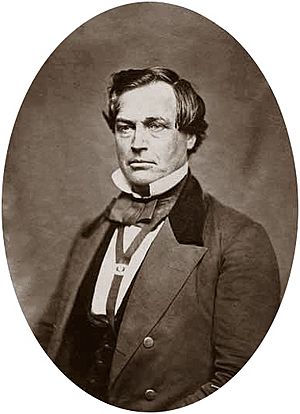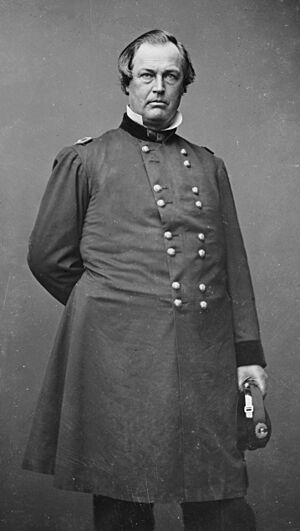James W. Denver facts for kids
Quick facts for kids
Jim Denver
|
|
|---|---|
 |
|
| 5th Governor of the Kansas Territory | |
| In office December 1857 – November 1858 |
|
| Preceded by | Robert J. Walker |
| Succeeded by | Samuel Medary |
| Member of the U.S. House of Representatives from California's at-large district |
|
| In office March 4, 1855 – March 3, 1857 |
|
| Preceded by | Milton S. Latham |
| Succeeded by | Joseph C. McKibbin |
| 2nd Secretary of State of California | |
| In office 1853–1855 |
|
| Governor | John Bigler |
| Preceded by | William Van Voohies |
| Succeeded by | Charles Hempstead |
| Personal details | |
| Born |
James William Denver
October 23, 1817 Winchester, Virginia, U.S. |
| Died | August 9, 1892 (aged 74) Washington, D.C., U.S. |
| Political party | Democratic |
| Education | University of Cincinnati (LLB) |
James William "Jim" Denver (October 23, 1817 – August 9, 1892) was an important American politician, soldier, and lawyer. He worked in the government of California and served as an officer in the United States Army during two wars. He was also a member of the Democratic party in the United States House of Representatives for California. Jim Denver was the secretary and later the Governor of the Kansas Territory. This was during a big debate about whether Kansas would allow slavery. The famous city of Denver, Colorado, is named after him!
Early Life and Career
James W. Denver was born near Winchester, Virginia. In 1830, he moved with his family to Ohio, settling near Wilmington. He taught school in Missouri in 1841. Later, in 1844, he finished law school at the University of Cincinnati. After becoming a lawyer, he practiced law near Xenia, Ohio. In 1845, he moved to Platte City, Missouri, where he continued his law work.
During the Mexican–American War in 1847, he helped create a military company. He became a captain and served under General Winfield Scott. After the war, in 1850, Denver went to California and became a trader. Later, in 1852, he was elected to the California State Senate. He was then chosen to be the Secretary of State of California.
In 1854, he was elected to the United States Congress to represent California. He served from March 4, 1855, to March 3, 1857. He did not run for re-election in 1856. On April 17, 1857, President James Buchanan made him the Commissioner of Indian Affairs.
On June 17, 1857, President Buchanan appointed Denver as the Secretary of the Kansas Territory. In December 1857, he became the Territorial Governor. On the day Denver became governor, people in Kansas voted on the Lecompton Constitution. This constitution would have allowed slavery in the territory. Many people who wanted to stop slavery, called Free-Staters, did not vote. This was because the vote only offered choices for full or limited slavery. The pro-slavery constitution passed by a large amount. However, it was later found that many votes were fake. These votes came from "Border Ruffians" who crossed from Missouri. The vote was later cancelled in 1858. Kansas eventually joined the United States in 1861 as a free state. You can learn more about this time in Bleeding Kansas.
In November 1858, while Denver was still governor, William Larimer, Jr. started a new town. Larimer was a land developer from Leavenworth. He started the town of "Denver City" along the South Platte River. This area was in western Kansas Territory, which is now the state of Colorado. Larimer named the town "Denver" to honor the governor. He hoped the city would become the main town of the county.
Denver stopped being territorial governor in November 1858. He was again made Commissioner of Indian Affairs. He served in this role until March 31, 1859.
Civil War and Later Career
A few months after the American Civil War began in 1861, President Abraham Lincoln made Denver a brigadier general. This was on August 14. In November 1861, he was sent to Fort Scott in Kansas. By December, he was in charge of all Federal troops in Kansas. He commanded the District of Kansas in early 1862. Then he moved to the District of West Tennessee.
On May 16, 1862, Denver took command of a brigade under Maj. Gen. William T. Sherman. This was during the Siege of Corinth. The very next day, Denver's brigade fought at Russell's House. His soldiers did well in this fight. On May 27, General Sherman again chose Denver's brigade to lead an attack against the Double Log House. Denver's brigade successfully took the log cabin that was used as a block house. Major General Ulysses S. Grant was there and approved of how the troops fought. After Corinth fell, Denver stayed in command of his brigade. He was on duty in Mississippi. During the early parts of the Vicksburg Campaign, Denver commanded a division. He left the Union Army on March 5, 1863.
After the war, Denver worked as a lawyer in Washington, D.C., and Wilmington, Ohio. He attended the Democratic National Convention in 1876, 1880, and 1884. People even thought he might be a Democratic presidential candidate in 1876 and 1884.
Denver visited Denver, Colorado, in 1875 and 1882. He said that the people in the city named after him did not show him much warmth. His second visit makes him the only person to visit their namesake city after it became a U.S. state capital.
He passed away in Washington, D.C., in 1892. He is buried in Sugar Grove Cemetery in Wilmington, Ohio.
His son, Matthew R. Denver, also became a U.S. Congressman for Ohio from 1907 to 1913.


